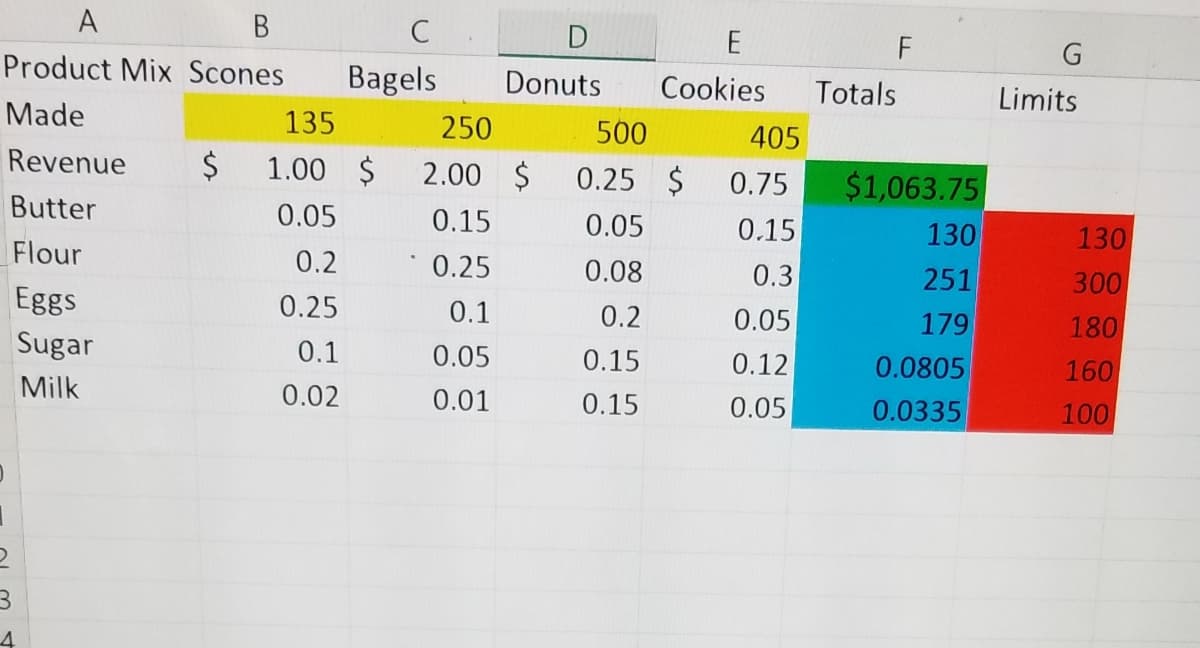Could anyone answer this problem? We have four products: Scones ($1 revenue) Bagels ($2 revenue) Donuts($0.25 revenue) Cookies ($0.75 revenue) You have 130 lbs of butter. You have 300 lbs of flour. You have 180 eggs. You have 160 lbs of sugar. You have 100 gallons of milk. A scone requires 0.05 lbs butter, 0.2 lbs flour, 0.25 eggs, 0.1 lbs sugar, and 0.02 gallons of milk. A bagel requires 0.15 lbs butter, 0.25 lbs flour, 0.1 eggs, 0.05 lbs sugar, and 0.01 gallons of milk. A donut requires 0.05 lbs butter, 0.08 lbs flour, 0.2 eggs, 0.15 lbs sugar, and 0.15 gallons of milk. A cookie requires 0.15 lbs butter, 0.3 lbs flour, 0.05 eggs, 0.12 lbs sugar, and 0.05 gallons of milk. To have enough items on display and to keep the bakers busy, you must produce at least 100 of each. However, since these are perishable goods, we seldom manage to sell more than 500 of each before the remainder go bad, so don’t make more than 500 of any item. Because of past demand patterns, you should make 2 donuts for each bagel and 3 cookies for each scone. How many of each type of item do we make? What happens when our constraints change? What happens if the objective function coefficient changes?
Could anyone answer this problem? We have four products: Scones ($1 revenue) Bagels ($2 revenue) Donuts($0.25 revenue) Cookies ($0.75 revenue) You have 130 lbs of butter. You have 300 lbs of flour. You have 180 eggs. You have 160 lbs of sugar. You have 100 gallons of milk. A scone requires 0.05 lbs butter, 0.2 lbs flour, 0.25 eggs, 0.1 lbs sugar, and 0.02 gallons of milk. A bagel requires 0.15 lbs butter, 0.25 lbs flour, 0.1 eggs, 0.05 lbs sugar, and 0.01 gallons of milk. A donut requires 0.05 lbs butter, 0.08 lbs flour, 0.2 eggs, 0.15 lbs sugar, and 0.15 gallons of milk. A cookie requires 0.15 lbs butter, 0.3 lbs flour, 0.05 eggs, 0.12 lbs sugar, and 0.05 gallons of milk. To have enough items on display and to keep the bakers busy, you must produce at least 100 of each. However, since these are perishable goods, we seldom manage to sell more than 500 of each before the remainder go bad, so don’t make more than 500 of any item. Because of past demand patterns, you should make 2 donuts for each bagel and 3 cookies for each scone. How many of each type of item do we make? What happens when our constraints change? What happens if the objective function coefficient changes?
Practical Management Science
6th Edition
ISBN:9781337406659
Author:WINSTON, Wayne L.
Publisher:WINSTON, Wayne L.
Chapter13: Regression And Forecasting Models
Section13.4: Multiple Regression Models
Problem 12P
Related questions
Question
Could anyone answer this problem?
We have four products:
Scones ($1 revenue)
Bagels ($2 revenue)
Donuts($0.25 revenue)
Cookies ($0.75 revenue)
You have 130 lbs of butter.
You have 300 lbs of flour.
You have 180 eggs.
You have 160 lbs of sugar.
You have 100 gallons of milk.
A scone requires 0.05 lbs butter, 0.2 lbs flour, 0.25 eggs, 0.1 lbs sugar, and 0.02 gallons of milk.
A bagel requires 0.15 lbs butter, 0.25 lbs flour, 0.1 eggs, 0.05 lbs sugar, and 0.01 gallons of milk.
A donut requires 0.05 lbs butter, 0.08 lbs flour, 0.2 eggs, 0.15 lbs sugar, and 0.15 gallons of milk.
A cookie requires 0.15 lbs butter, 0.3 lbs flour, 0.05 eggs, 0.12 lbs sugar, and 0.05 gallons of milk.
To have enough items on display and to keep the bakers busy, you must produce at least 100 of each.
However, since these are perishable goods, we seldom manage to sell more than 500 of each before the remainder go bad, so don’t make more than 500 of any item.
Because of past demand patterns, you should make 2 donuts for each bagel and 3 cookies for each scone.
How many of each type of item do we make?
What happens when our constraints change?
What happens if the objective function coefficient changes?

Transcribed Image Text:A
B
Product Mix Scones
Made
Revenue
Butter
Flour
3
4
Eggs
Sugar
Milk
$
C
Bagels
D
E
Donuts Cookies
135
250
500
405
1.00 $ 2.00 $ 0.25 $ 0.75
0.05
0.15
0.05
0.15
0.2
0.25
0.08
0.3
0.25
0.1
0.2
0.05
0.1
0.05
0.15
0.12
0.02
0.01
0.15
0.05
Totals
F
$1,063.75
130
251
179
0.0805
0.0335
Limits
130
300
180
160
100
Expert Solution
This question has been solved!
Explore an expertly crafted, step-by-step solution for a thorough understanding of key concepts.
This is a popular solution!
Trending now
This is a popular solution!
Step by step
Solved in 2 steps with 5 images

Recommended textbooks for you

Practical Management Science
Operations Management
ISBN:
9781337406659
Author:
WINSTON, Wayne L.
Publisher:
Cengage,

Practical Management Science
Operations Management
ISBN:
9781337406659
Author:
WINSTON, Wayne L.
Publisher:
Cengage,